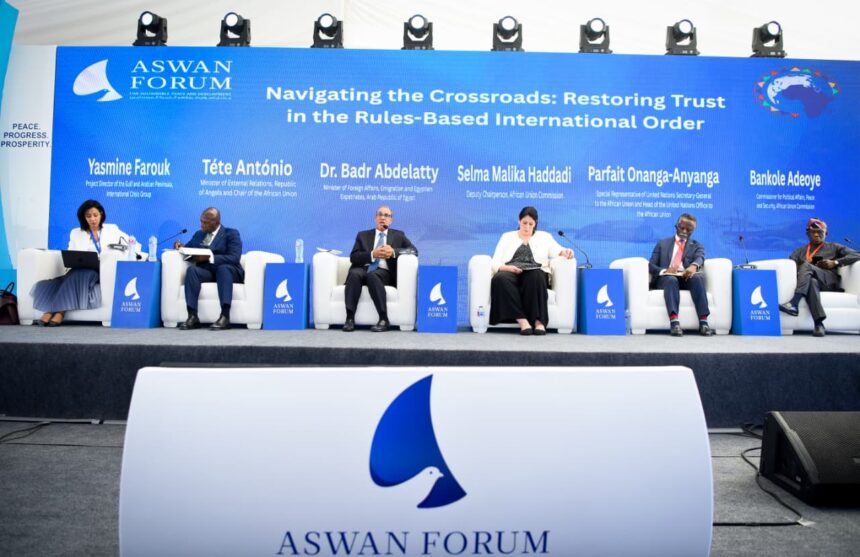EGX surge signals confidence in reform momentum
EGX30:IND hits 38,000 as EGP=X steadies near 47.5; CBE rate cut to 21.0% and reserves at $49.5 bn sustain investor confidence while BZ=F and CL=F stabilize below $62, supporting Egypt’s fiscal-monetary balance.

Egypt leveraged the fifth Aswan Forum for Sustainable Peace and Development, held on 19–20 October 2025, to reinforce its positioning as Africa’s leading financing and trade hub. Convened under the theme “A World in Flux, A Continent in Motion,” the forum brought together governments, multilateral banks, and private investors to accelerate cross-border infrastructure, trade integration, and institutional reform.
It coincided with stabilizing domestic macro fundamentals—urban inflation eased to 11.7% in September from 12.0% in August, foreign reserves rose to USD 49.5 billion (about 5–6 months of import cover), and the EGX 30 index (EGX30:IND) reached record highs near 38,000 points.
For Egypt, the event functions as an extension of its broader capital-market and external-funding strategy. External financing needs for FY 2025/26 are estimated at USD 30–35 billion, roughly 9 percent of GDP. Rather than rely on bilateral lenders, the authorities aim to diversify through syndicated facilities, blended-finance platforms, and increased market issuance.
The Central Bank of Egypt’s 100-basis-point policy-rate cut on 2 October 2025—to 21.0 percent on deposits and 22.0 percent on lending—re-anchors the interest-rate corridor after three consecutive holds earlier in the year. With inflation in the low double digits, the ex-ante real policy rate remains above 9 percentage points, ensuring positive carry and continued investor appetite for Egyptian local-currency debt. Ten-year yields hover between 20.4 and 21.9 percent, suggesting gradual curve flattening as disinflation expectations firm.
The fiscal-monetary alignment creates space for capital reallocation. October’s 12 percent average fuel-price adjustment narrows subsidy leakage and improves the primary balance trajectory for FY 2025/26, complementing tighter monetary conditions without suppressing growth. The government’s medium-term fiscal framework targets a primary surplus near 1.5 percent of GDP and overall deficit containment below 6 percent. Together with stable reserves and positive real yields, this stance signals to global investors that Egypt’s funding model is shifting from short-term liquidity management toward rule-based liability optimisation.
At the regional level, the Aswan Forum underscores Africa’s widening infrastructure-finance gap—estimated at USD 130–170 billion per year through 2030—and Egypt’s intent to intermediate part of that flow. The African Continental Free Trade Area (AfCFTA) still accounts for only 17 percent of total continental trade; policymakers target 25 percent by 2027. Egypt’s Suez, Red Sea, and Mediterranean corridors form the backbone of this trade-integration strategy, with multiplier effects estimated at 1.4 times for each dollar invested in transport and logistics. As the forum formalises project pipelines linking East and North Africa, the outcome extends beyond diplomacy: it builds tangible, investable assets aligned with sovereign-credit transparency and market discipline.
Market signals validate the shift. The EGX 30 has outperformed most emerging-market peers this quarter, while the pound (EGP=X) trades in a tighter EGP 47.3–47.7 band, supported by reserve accumulation and improved confidence in the CBE’s managed-float regime. Eurobond spreads tightened about 35 basis points in the week of the forum’s opening, and foreign participation in local-debt auctions edged higher. The high real-yield environment continues to attract carry-trade inflows even as domestic institutions lengthen duration. Egypt’s external profile now looks less vulnerable to short-term shocks than during the 2022–2023 liquidity crunch, when reserves briefly fell below USD 35 billion.
Global context reinforces this narrative. Brent crude (BZ=F) near USD 61 per barrel and WTI (CL=F) at USD 58 reduce Egypt’s import-cost base and moderate inflation, while lower global food prices narrow the current-account deficit to a projected 2.5–3.0 percent of GDP in FY 2025/26. The 10-year U.S. Treasury yield at 4.6 percent sets the external reference point for Egypt’s risk premium, which has compressed by roughly 100 basis points since January. The country’s ability to sustain real positive yields and a functioning capital market distinguishes it from higher-risk peers across North Africa, where monetary frameworks remain less transparent.
Forward indicators are measurable. Through mid-2026, success will hinge on four metrics: headline CPI trending toward 9–10 percent, reserves exceeding USD 50 billion, EGX 30 turnover expanding 15 percent year-on-year, and at least USD 5–7 billion of forum-aligned infrastructure financings reaching close. If these thresholds are met, Egypt’s credit spreads could tighten another 50 basis points, reinforcing its position as the anchor for Africa’s trade-finance ecosystem. Failure to deliver would expose lingering fiscal-execution and project-governance risks, delaying the country’s full transition from stabilisation to investment-led growth.





